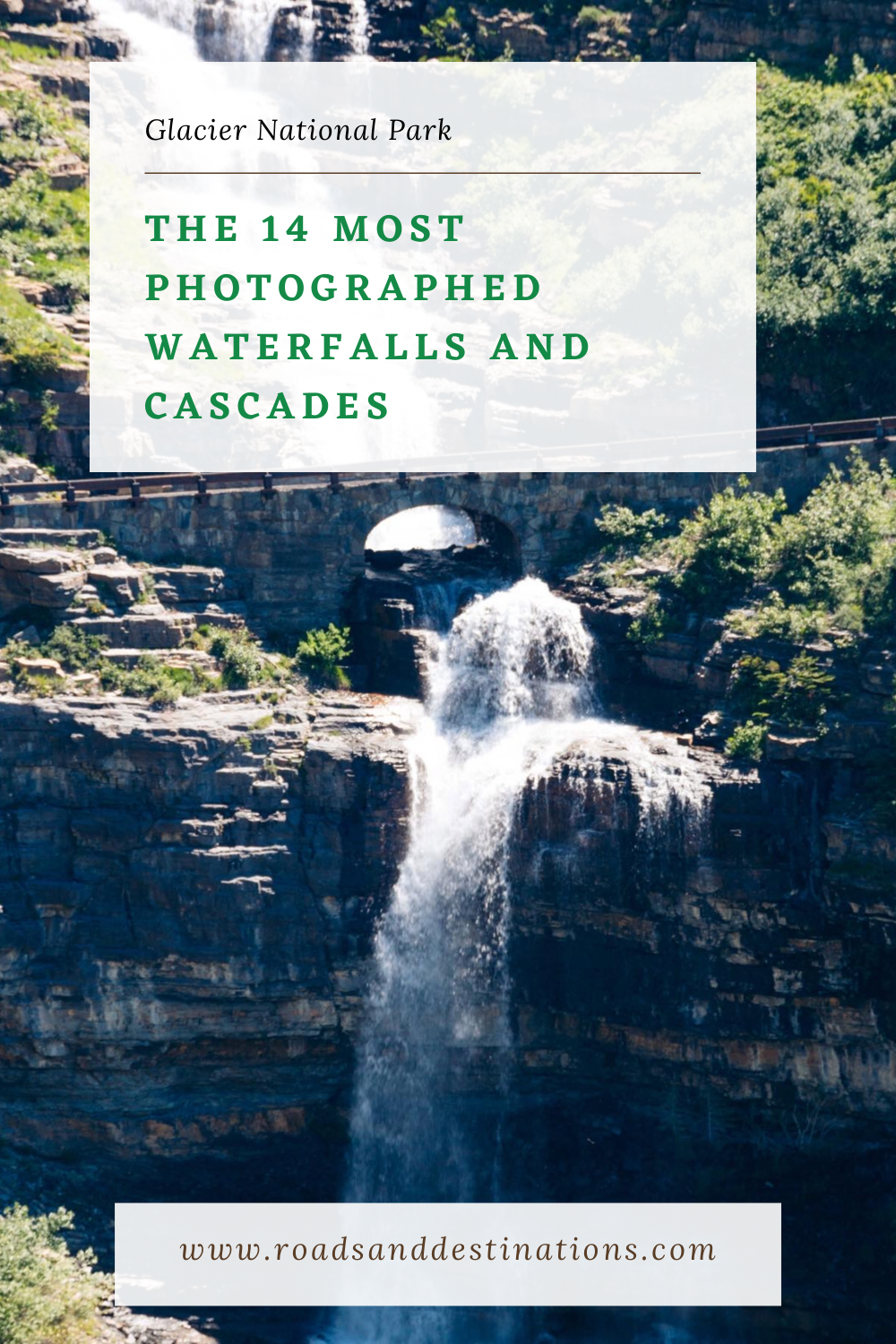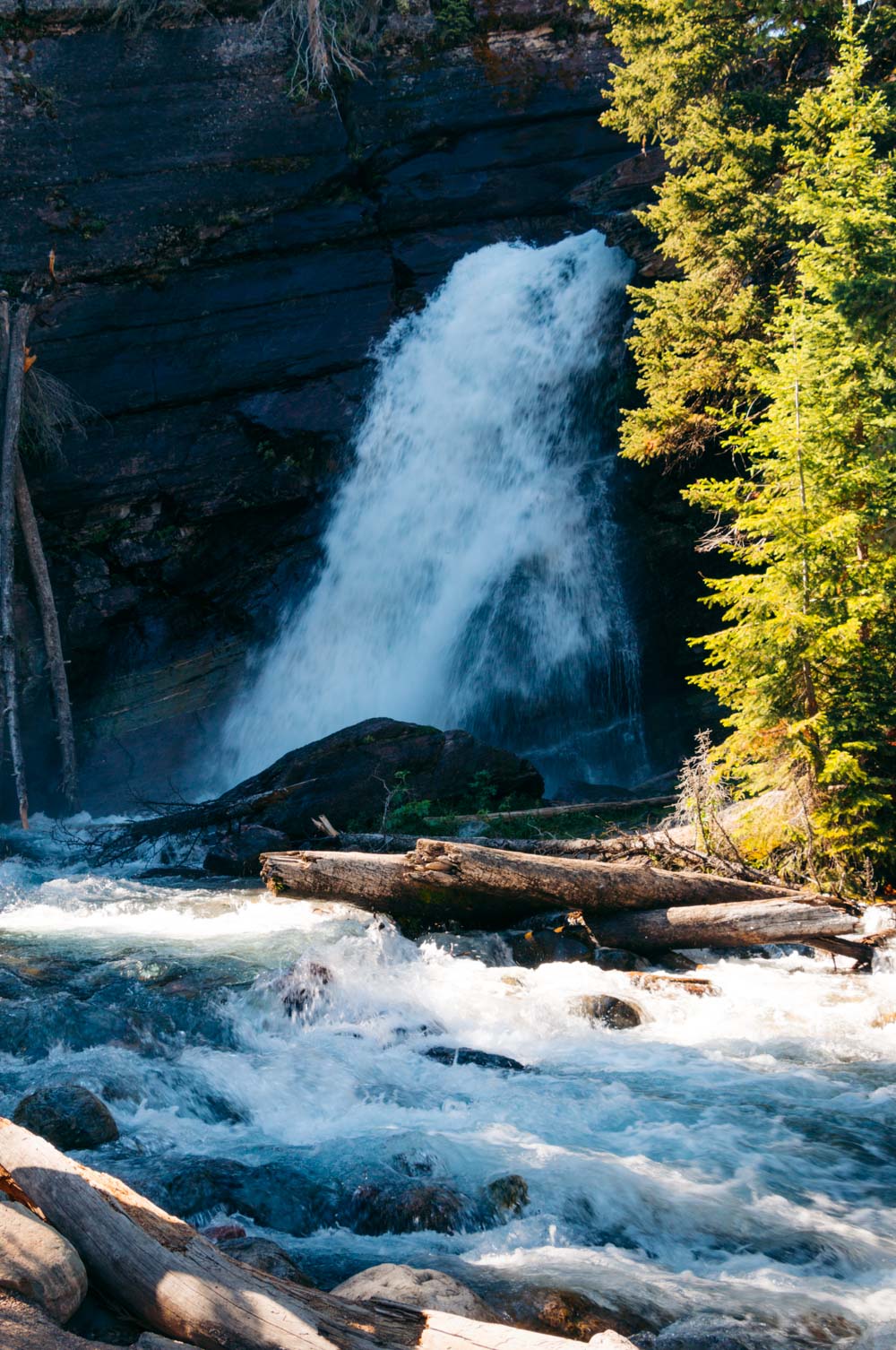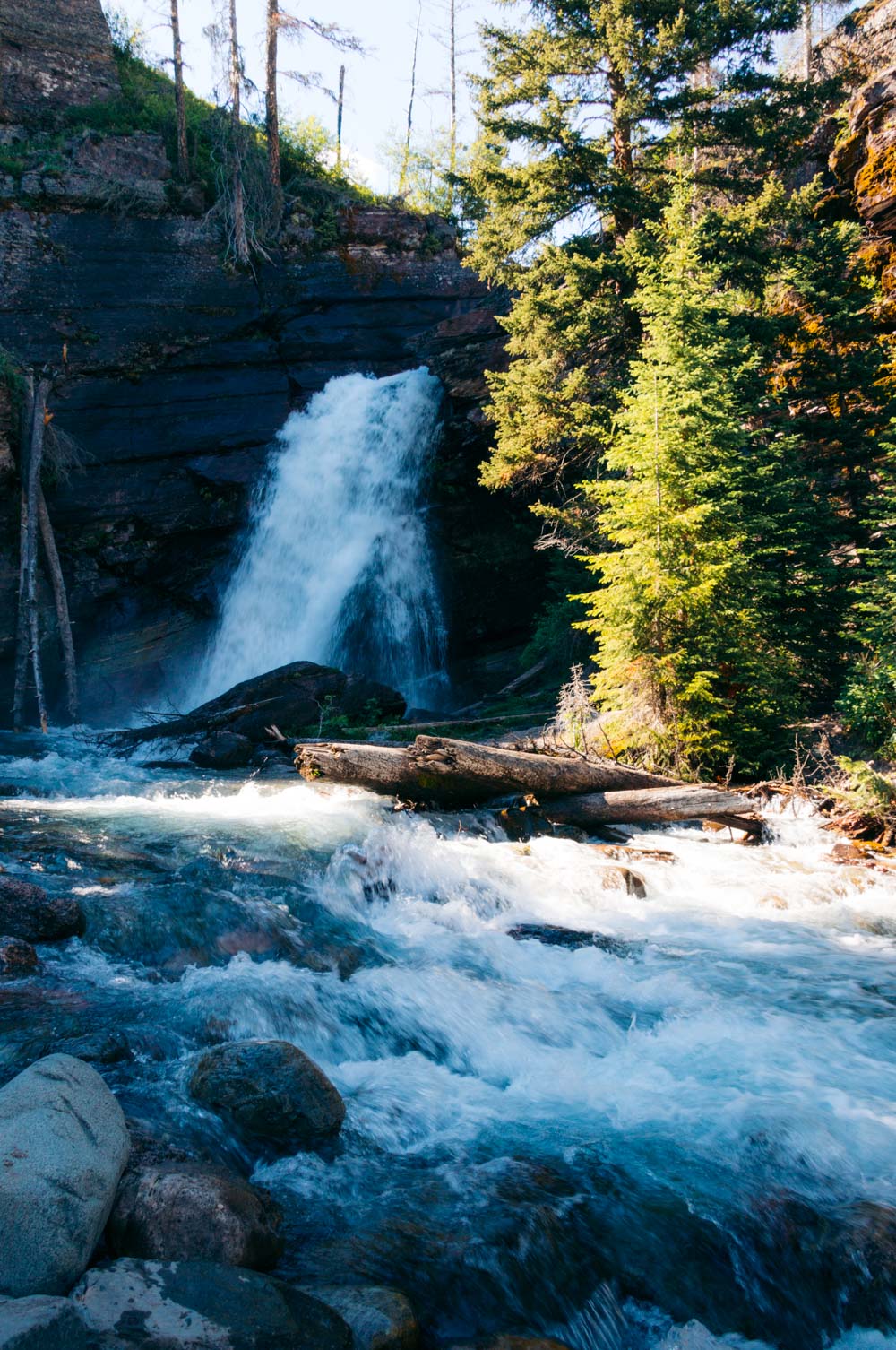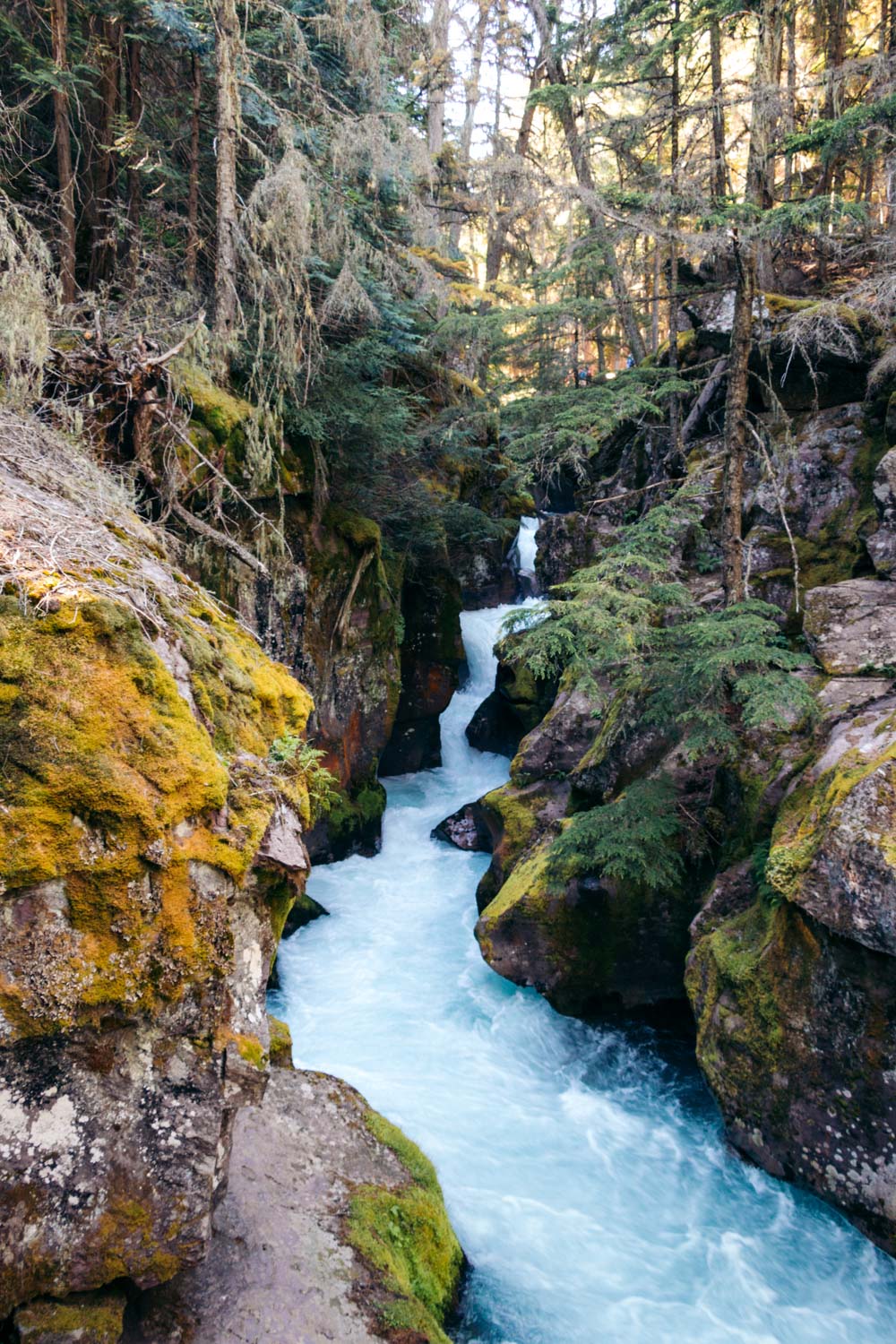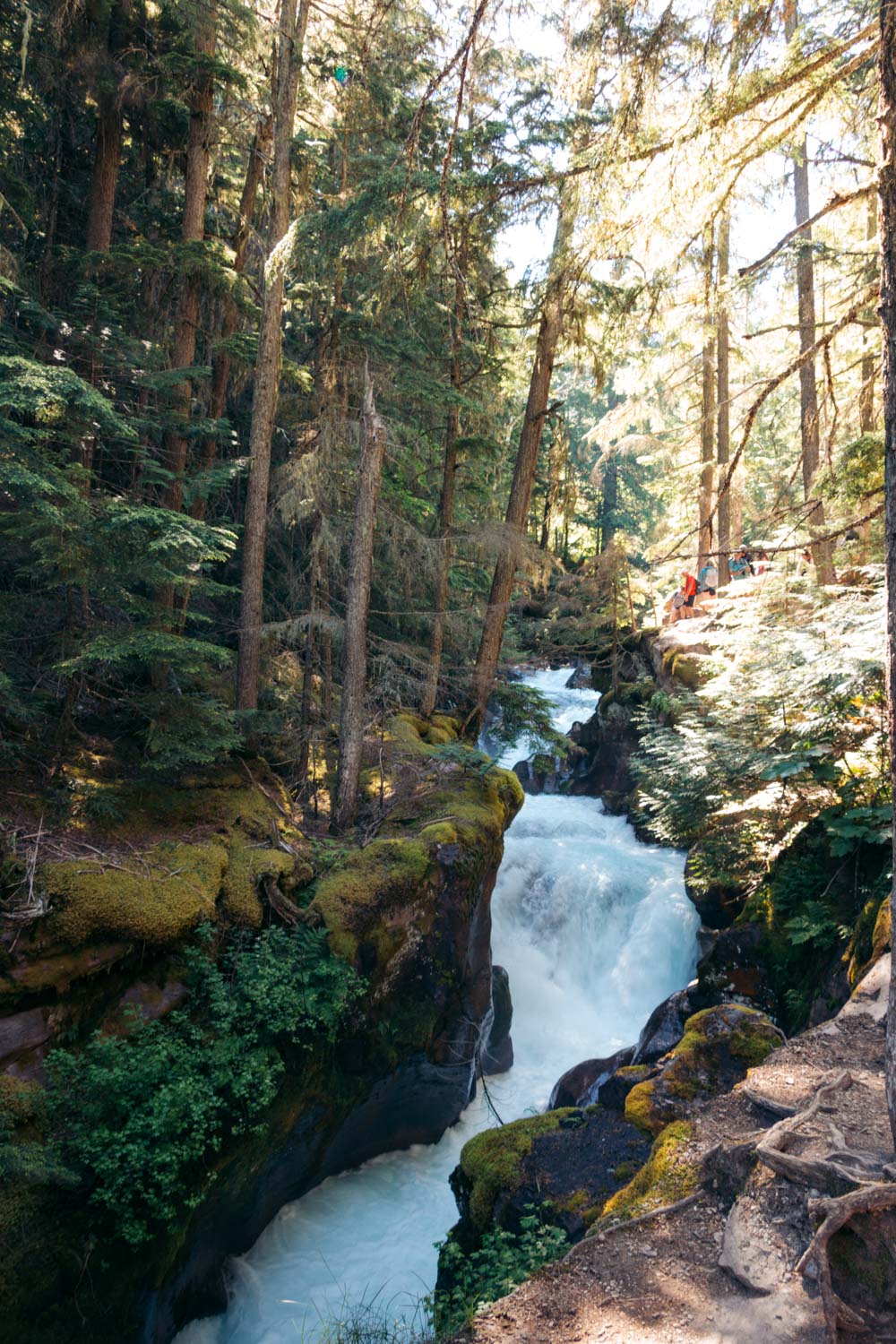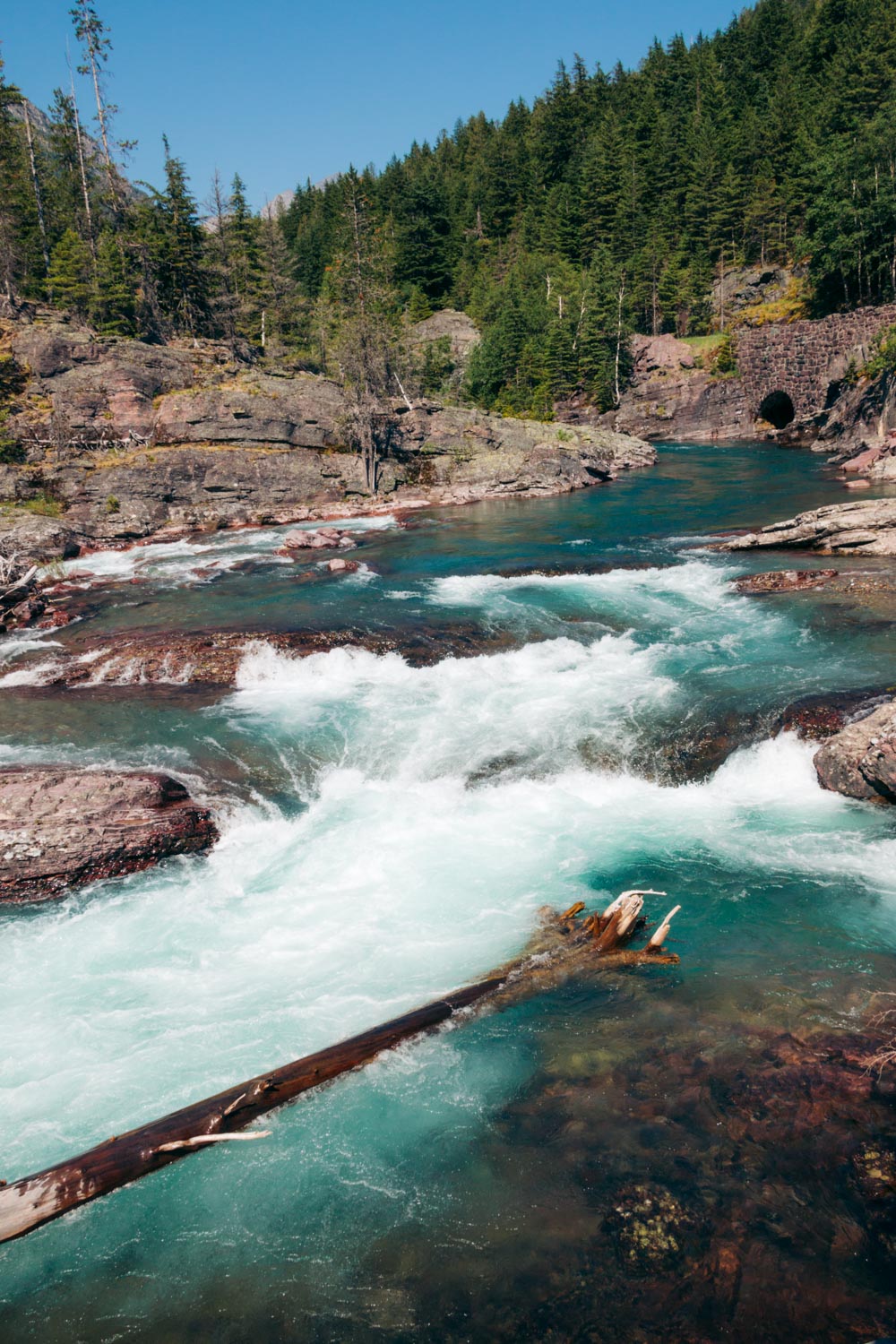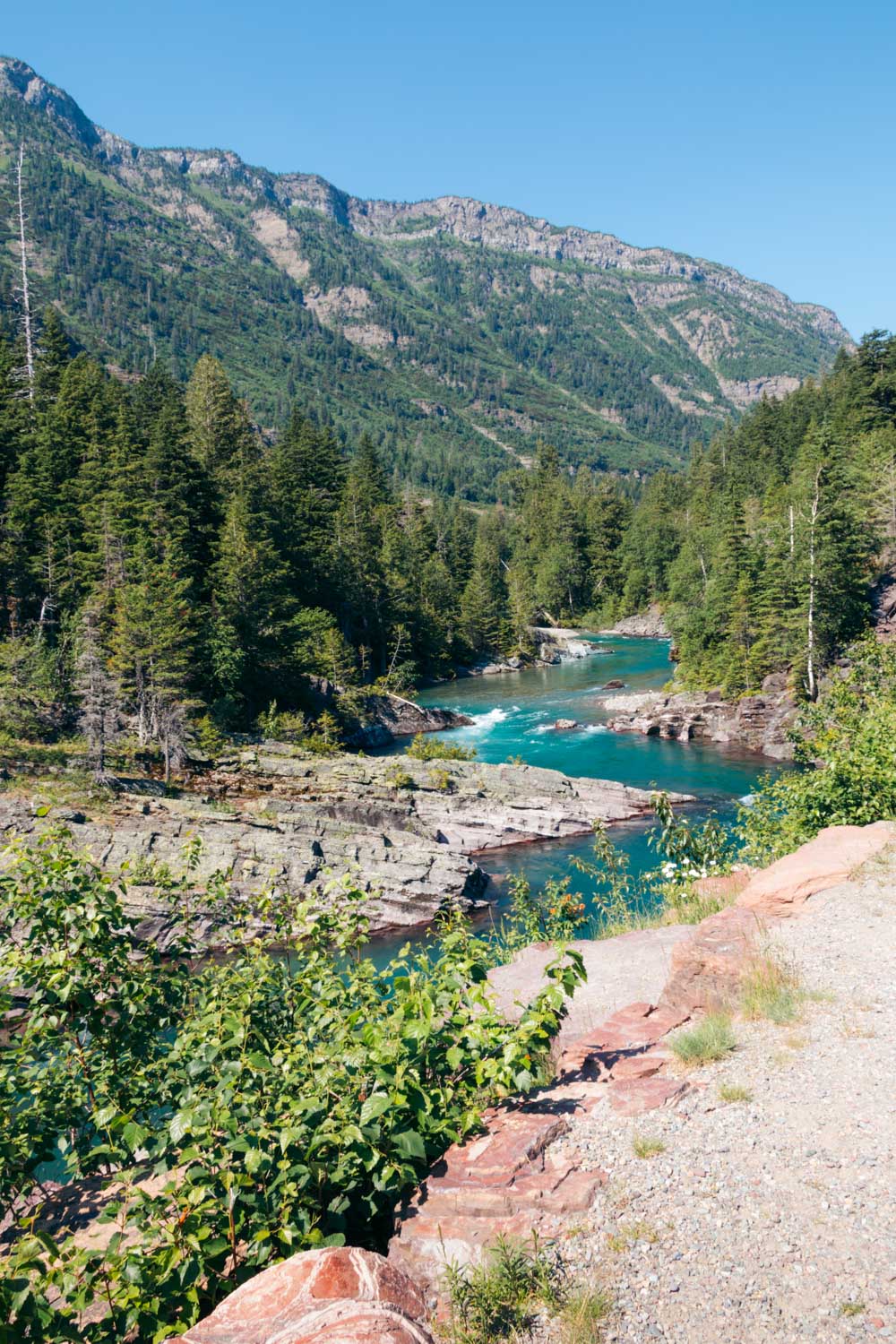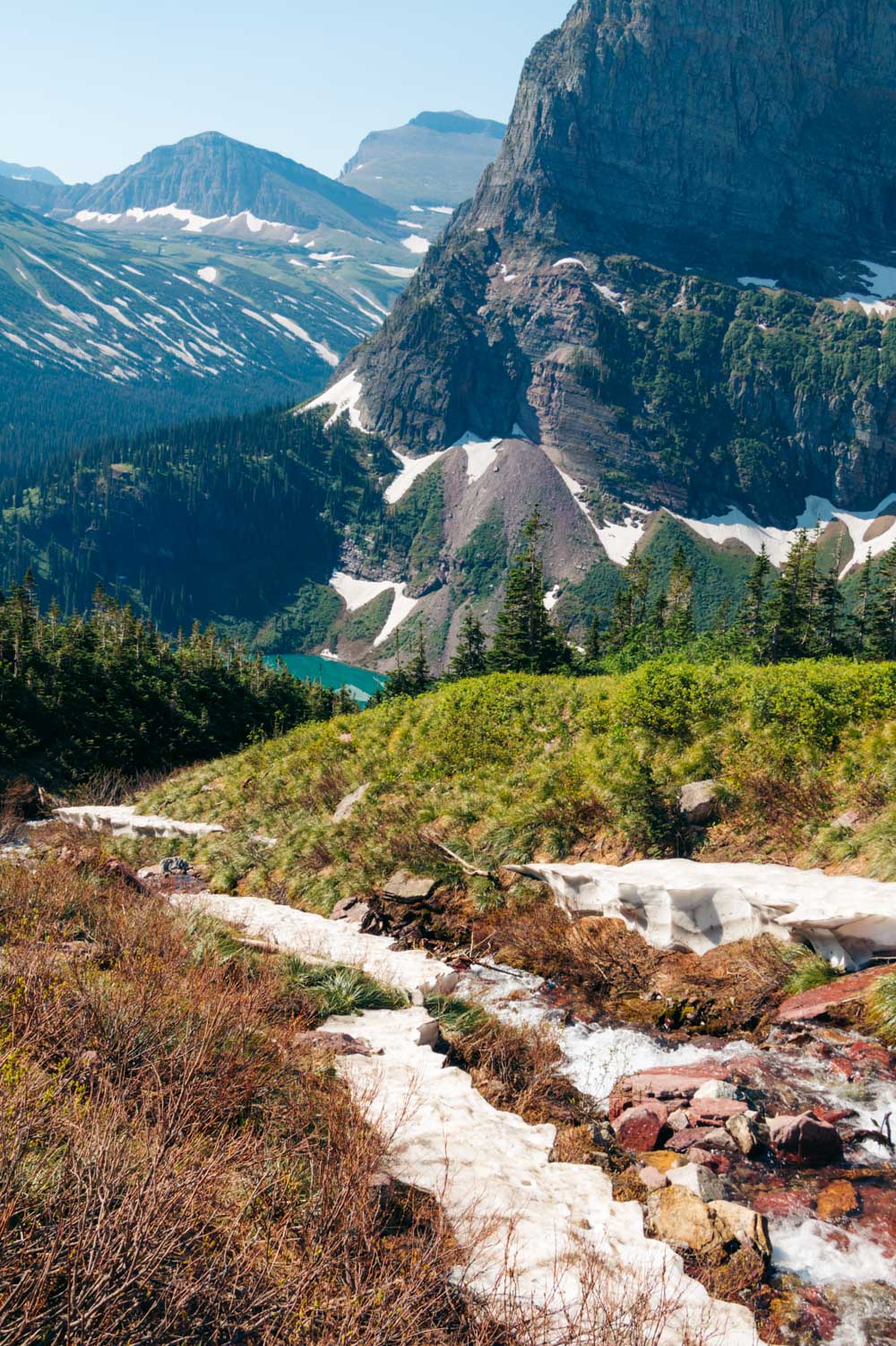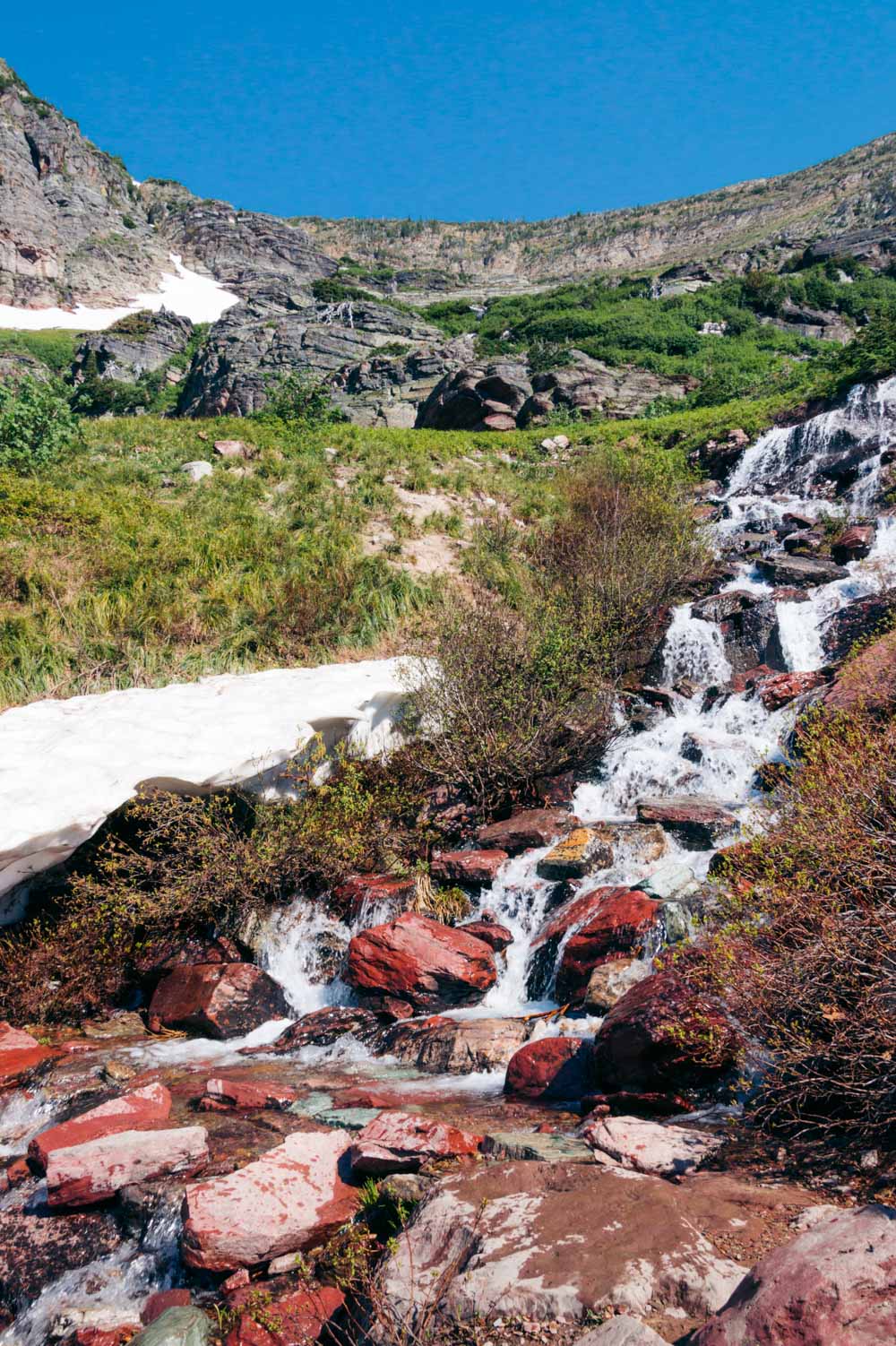With hundreds of glacier-fed falls, creeks, and cascades, photographing waterfalls in Glacier National Park is a sheer joy and delight.
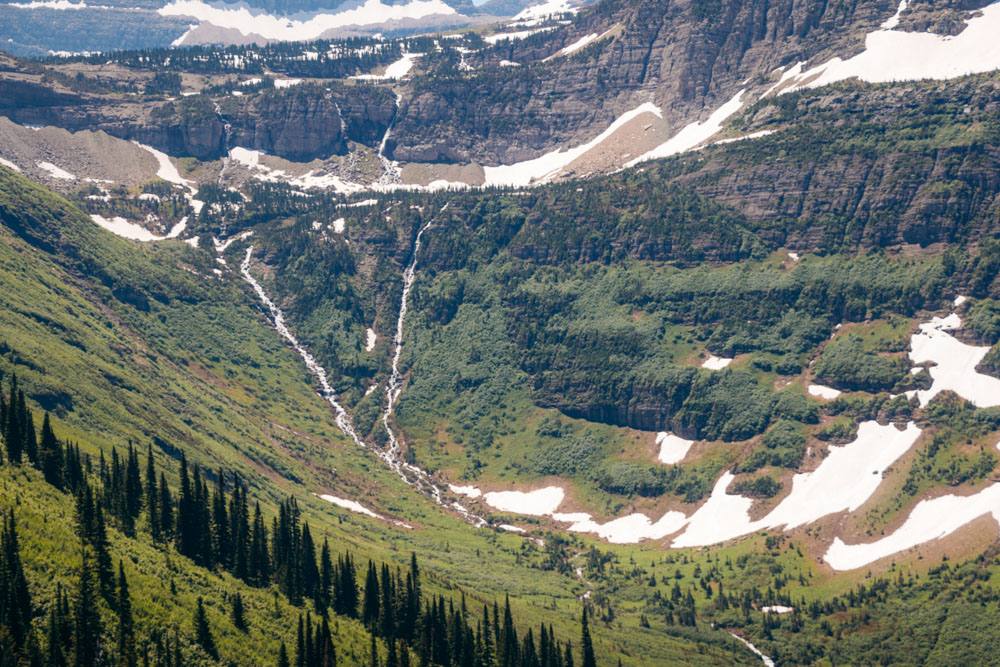
The Most Photographed Cascades and Waterfalls in Glacier National Park
You travel to Glacier National Park to admire its stunning mountain scenery, not roaring waterfalls and cascades. Let’s just be clear on that. Known as a place that reminds you of Switzerland in North America, the area astounds with its towering peaks and lush meadows for miles on end. To photograph those jaw-dropping waterfalls, you should visit Oregon, not Glacier National Park.
And that’s how wrong I was…
My idea of what to do and see in Glacier National Park certainly was far from reality. Logically, I should’ve expected to find and – since I always travel with a camera – photograph the majestic waterfalls and roaring cascades in Glacier National Park.
Yet I continued researching the best hikes and lushest meadows until I came across St. Mary Falls and Virginia Falls. So apparently, Glacier National Park housed a number of multi-layer waterfalls, some of which were considered the most photographed waterfalls in Montana.
As I looked deeper into this topic and later, equipped with my camera, explored the area, I realized how awfully wrong I was in the first place. With more than 200 waterfalls and cascades, Glacier National Park is a photographer’s paradise.
Prelude to the Most Photographed Waterfalls and Cascades in Glacier
The falls are scattered throughout the park and often don’t have names. Those lucky waterfalls that received their names at some point in the past are the crown jewels of Glacier National Park and have been photographed over and over again.
To further ignite your falls-photography thirst, some of these roaring waterfalls and cascades sit right by the Going-to-the-Sun Road in West and East Glacier. Other representatives of Glacier National Park’s most photographed waterfalls nestle around alpine lakes and secluded creeks. To see this particular watery opulence, you must hike.
Are you ready for an adventure now that you know what to expect? Then let’s dip our feet into freezing cold pools at the bottom of some of the most photographed cascades and waterfalls in Glacier National Park.
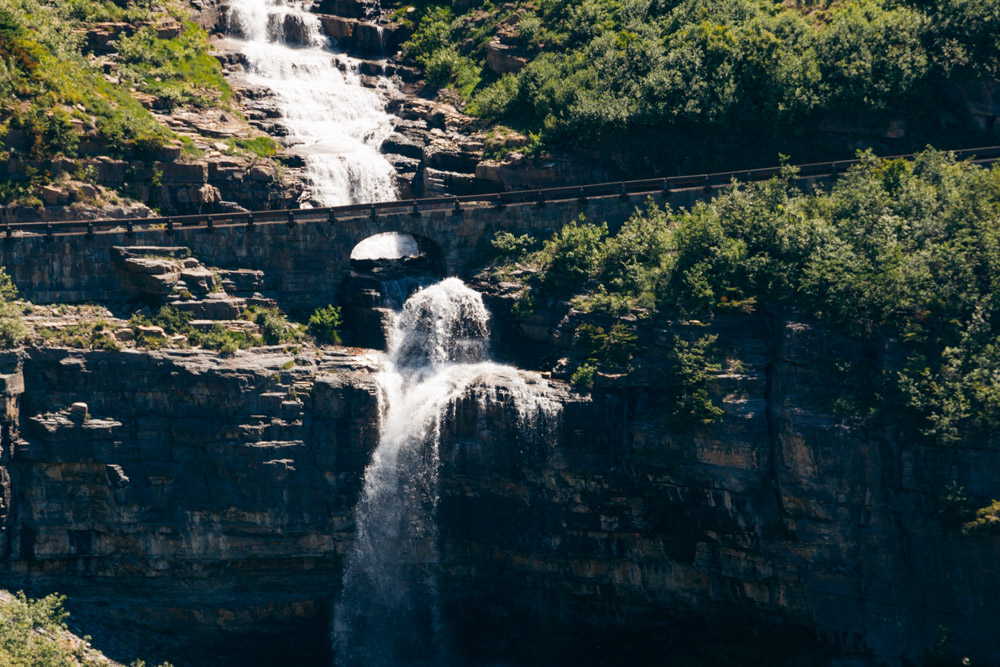
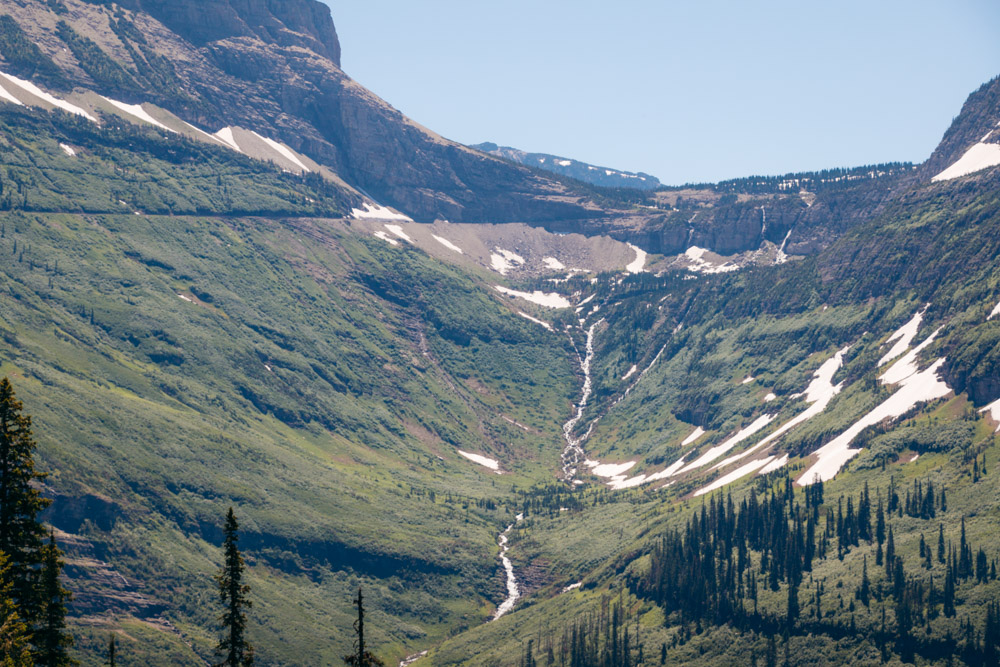
THE MOST POPULAR CASCADES AND WATERFALLS TO PHOTOGRAPH IN GLACIER NATIONAL PARK: GOING-TO-THE-SUN ROAD AREA
1. St. Mary Falls
Ironically, St. Mary Falls, one of the three most photographed waterfalls along the Going-to-the-Sun Road in East Glacier didn’t end up on my itinerary. In reality, it did. But after hiking for more than 10 miles a day with a small kid, I didn’t have any energy left to tread to this fall.
Nevertheless, it’s not an excuse to leave St. Mary Falls behind, especially if you’re after the most recognizable waterfalls in Glacier National Park.
The natural wonder sits 0.8 mile away from St. Mary Falls Shuttle Stop and impresses with its roaring waters dropping roughly 35 feet in three separate tiers. The two largest sections of the falls offer the stunning foresty ambiance that landscape photographers can’t get enough of. The third, smaller waterfall runs under a nearby footbridge.
Photography Tip: It’s recommended to start capturing the images of the waterfalls from the bridge first. Once you’re done with this mission, follow a path underneath the wooden structure to find the best views of one of the most photographed waterfalls in East Glacier.
TIP: Alternatively, you can start your journey to St. Mary Falls at the St. Mary Falls trailhead. The hike is a little big longer from here, adding 0.4 mile to the trail for a total of 1.2-mile, one-way trip.
2. Virginia Falls
Once you’ve collected enough images of St. Mary Falls, you can return to your car or follow the trail to Virginia Falls. This multi-tier natural phenomenon is nestled only 0.6 mile away from St. Mary Falls and is recognized as one of the most favorite waterfalls to photograph in Glacier National Park. The entire hike comes close to traversing the 3.6-mile, round-trip trail. The views are, however, worth every step.
The largest section of Virginia Falls is the main inspiration for the Glacier National Park’s photographers. The waterfall drops approximately 50 feet, creating dreamy clouds from the spray.
On the other hand, this fresh coolness often presents serious inconveniences for the waterfall photographers. Frequently, the water drops land on cameras’ lenses and interfere with those flawless images you strive for when photographing one of the most beautiful waterfalls in Glacier National Park.
Photography Tip: Regardless of these minor obstacles, Virginia Falls looks absolutely incredible at any time of the day. The photographers, however, should head to the waterfall early in the morning or late in the afternoon to avoid crowds of visitors.
TIP: To get to both of these waterfalls in East Glacier, you’ll need to hike though the forest, including the area that was burned during the Reynold Creek Fire of 2015. Therefore, make sure to wear good, non-slip hiking shoes.
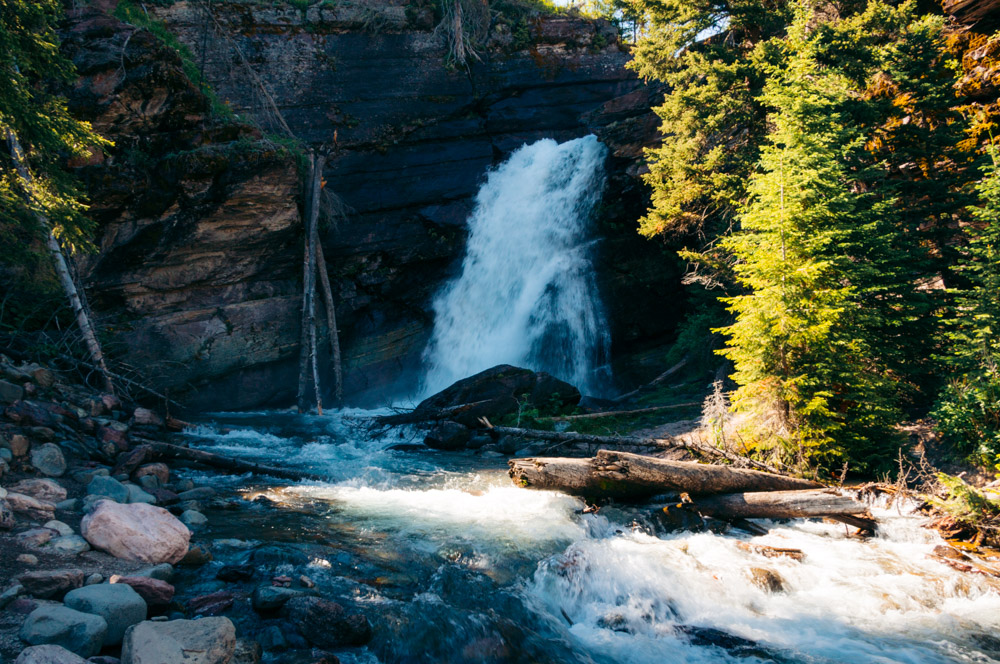
3. Baring Falls
The last falls in a trio of the favorite waterfalls in Glacier National Park’s Going-to-the-Sun Road area, Baring Falls sits farther down the trail. Continue walking for the full 6.4-mile, round-trip hike or make this waterfall a separate photographic journey.
In the latter case, you have two choices. Hiking along a 0.6-mile, round-trip trail from a parking lot near Sunrift Gorge is the easiest and most popular way to see Baring Falls.
Photography Tip: For photographers that welcome unexpected surprises in their pursuit of shooting the most beautiful waterfalls in Glacier National Park, I’d suggest taking a 2-mile, round-trip trail from the Sun Point parking lot. Here, glorious views of aquamarine St. Mary Lake on your left serve as a prelude to successful photo session at Baring Falls.
TIP: The waterfall drops roughly 25 feet over rock ledge. To soak your feet in the pool at the bottom of one of the most secluded waterfalls in this section of Glacier, you need to cross a small footbridge. Before you do it, though, linger a little bit longer on the narrow crossing to shoot the falls from different angles.
Unlike St. Mary Falls and Virginia Falls, the last member of the famous trio sees far fewer visitors. This, in its turn, benefits most of the photographers wishing to spend as little time editing out random people from their waterfall pictures as possible.
READ MORE: How to Hike to Baring Falls in Glacier NP: 3 Trail Options
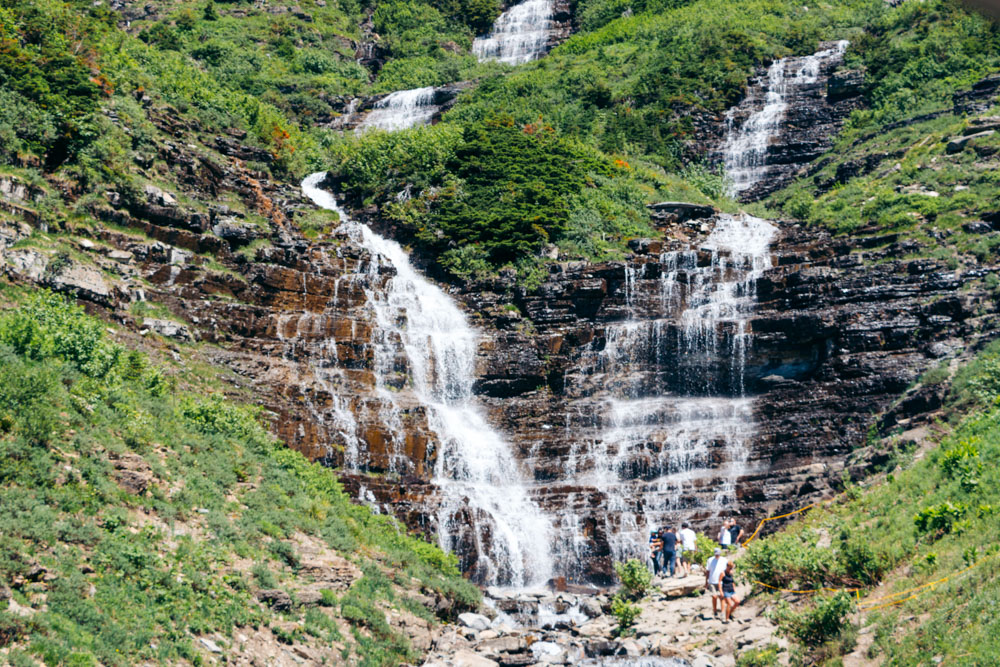
4. Waterfall at Lunch Creek
The waterfall at Lunch Creek can be easily classified as one of the most popular cascades in Glacier National Park. The roaring falls sits along the Going-to-the-Sun Road, one mile east of Logan Pass.
Cascading down Pollock Mountain, the place has long allured Glacier’s guests. Early travelers used it as a resting point while hiking along the Continental Divide. The historic landmark hasn’t lost its attractiveness as the years passed by. Many visitors still stop here to admire the untamed cascades streaming down from the mountain tops behind them.
There is no official trail. The hikers usually follow the cascading creek to the mountainside. Sadly, though, a lot of wildflowers get destroyed under the feet of careless travelers every year.
TIP: If hiking is the last thing on your mind at this point, pull over for a quick photo shoot of this epic member of the astonishing family of the roadside cascades and waterfalls in East Glacier.
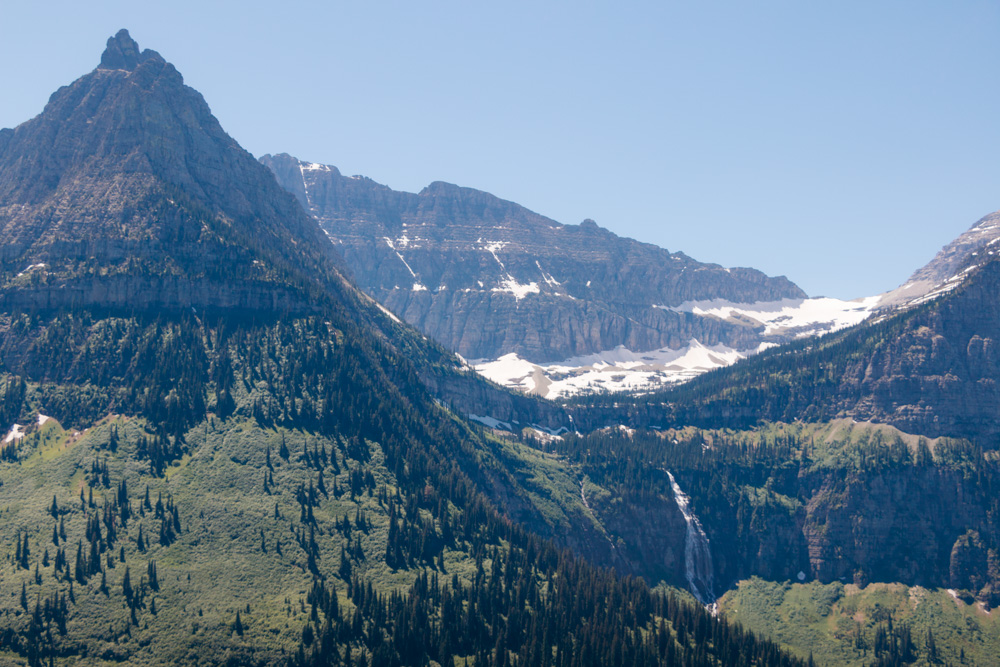
5. Bird Woman Falls
Bird Woman Falls looks dramatic. At 560 feet, it’s one of the tallest waterfalls in this section of Glacier National Park. Fed by snowfields and a remaining glacier, the waterfall sits below some of the tallest peaks in the Going-to-the-Sun Road area.
Photographing the finest of the finest waterfalls in Glacier couldn’t be easier. A number of easily accessible overlooks along the scenic route offer incredible views of the site. The most popular viewpoint, though, nestles east of the West Tunnel. This place also features a signage with some of the details about one of the must-see waterfalls in Glacier.
With that said, Bird Woman Falls can be seen from a distance of 2 miles. It makes sense to bring along a telephoto lens and practice with different ways of shooting the flowing down water.
Photography Tip: The best time to photograph most of the waterfalls in Glacier National Park is always spring when the melted snow feeds the falls. Bird Women Falls certainly belongs to these type of the waterfalls. Its flow is at its greatest in spring and the beginning of summer. The waterfall almost dries up by fall.
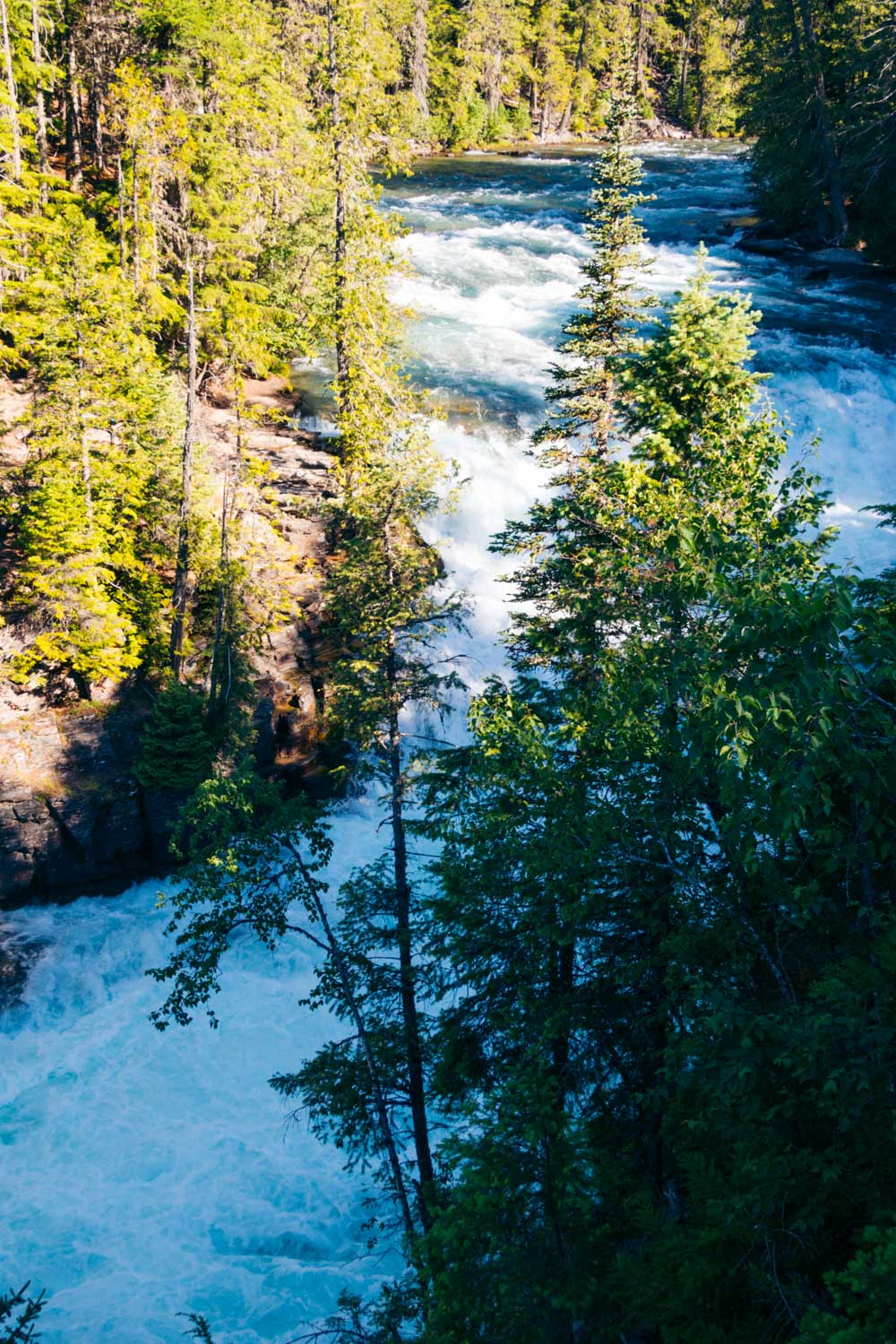
6. McDonald Falls
Your search for the most photographed roadside cascades and waterfalls in Glacier National Park has no end. If you start your journey in West Glacier and proceed along the Going-to-the-Sun Road to the eastern side of the park, keep your eyes peeled for McDonal Falls. Nestled near northern shore of Lake McDonald, the forceful waters of the waterfall stream down until they eventually plunge into the lake.
Photography Tip: As it’s the case with the most roadside waterfalls in this part of Glacier, photographing McDonald Falls takes a few minutes. A perfect vantage point is located just above the waterfall. Alternatively, you can take a short walk to get closer to the cascades.
The waterfalls in this section of Glacier National Park look calm in summer. In spring, though, they transform into smashing torrents, carrying trees and rocks.
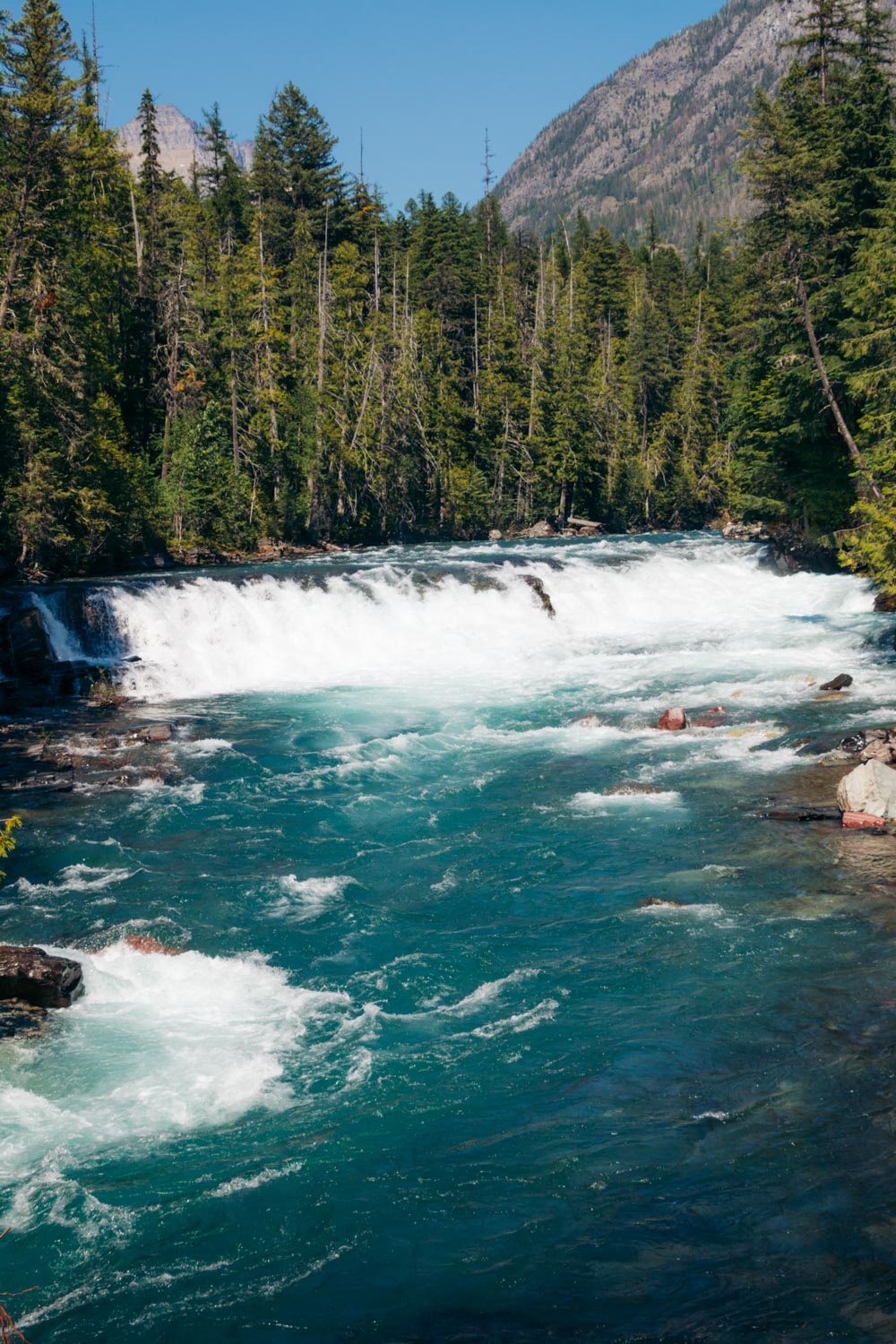
7. Sacred Dancing Cascade
Sacred Dancing Cascade is the next set of waterfalls to photograph on your way from West Glacier to East Glacier. Similar to McDonald Falls, the site nestles near the Going-to-the-Sun Road and allures with its powerful cascades.
Interestingly, I didn’t even notice a sign to the Sacred Dancing Cascade Overlook when we drove along the scenic route the first time. Eager to claim our parking spots at such favorite places as Logan Pass and the Avalanche Lake trailhead, we simply rushed through the area.
TIP: For more information on what to know and how to visit the popular places, including the waterfalls, along the scenic drive, read Visit Going-to-the-Sun Road in Glacier National Park: Tips and Entry Ticket.
As we were heading back to Kalispell after two nature-infused days in Glacier National Park, more and more roadside waterfalls caught our attention. Sacred Dancing Cascade with its photogenic, plunging rapids was one of them.
When we pulled off near a small overlook in the late afternoon, the parking area was almost empty. Too tired for one more proper hike, but never too exhausted for another round of the Glacier National Park’s photogenic waterfalls, we walked down to a wooden observation platform and greedily stared at the cascades.
Our Glacier journey was almost over at that time. So we tried to capture as many mental images of the Glacier National Park’s waterfalls and cascades as possible to last until next time.
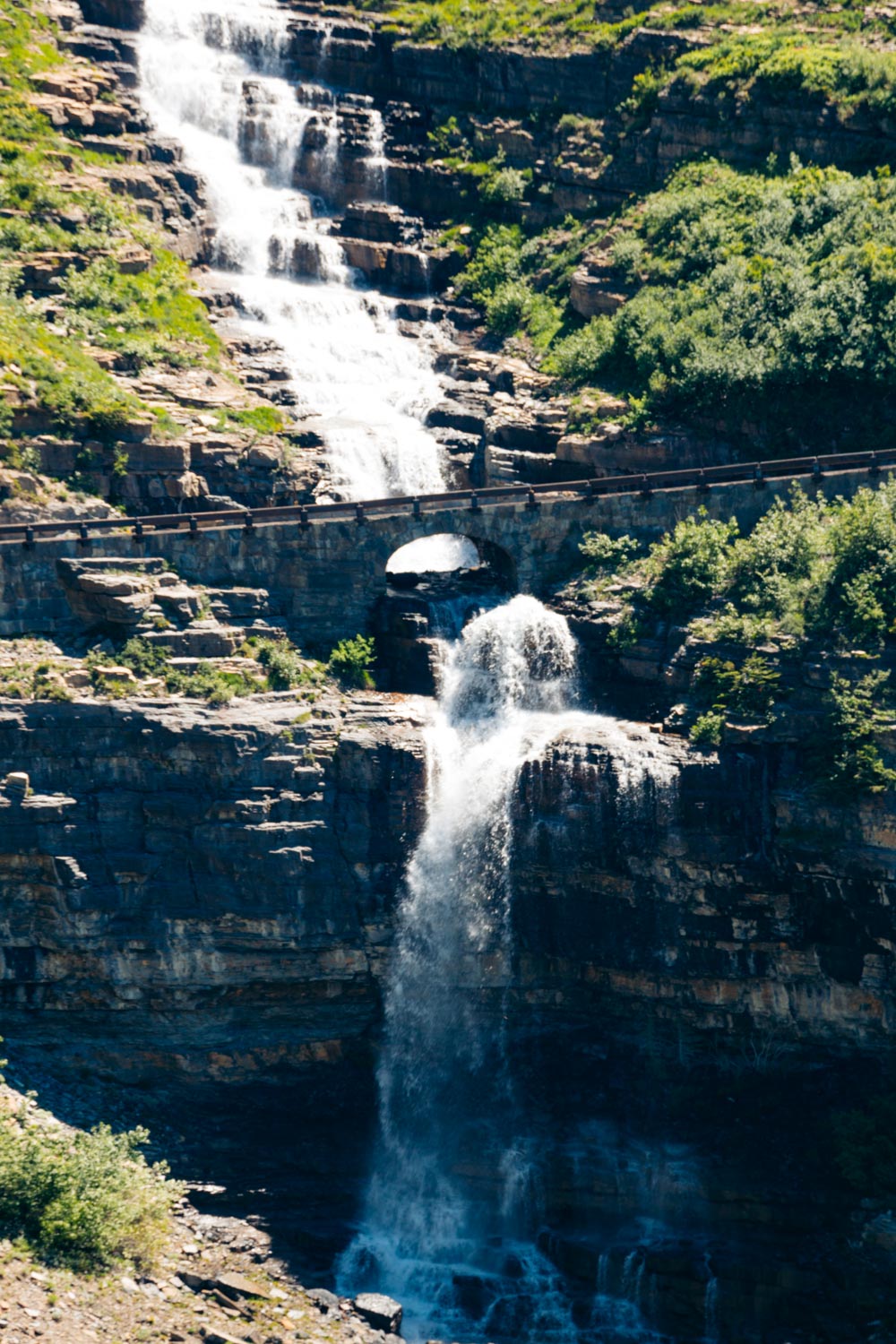
Unnamed waterfalls in Glacier 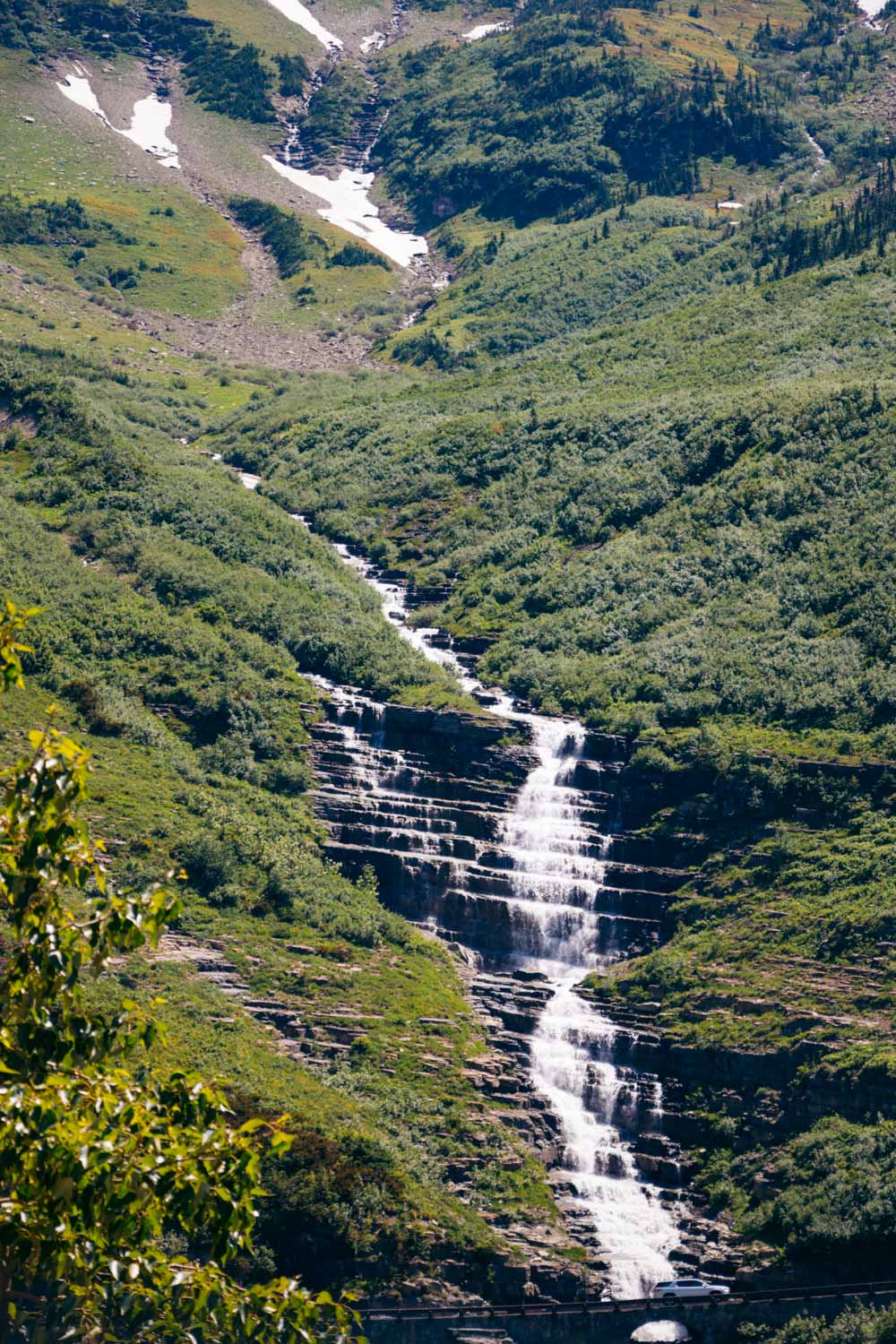
Haystack Creek Falls
8. Unnamed Waterfall at Haystack Creek
The unnamed falls at Haystack Creek is among the most scenic waterfalls and cascades in Glacier National Park. Gushing down the mountainside in a series of tiny torrents, this natural wonder is an indisputable show stealer. Crowds of visitors gather by the side of the Glacier’s scenic route to take in the splendid views and photograph the multiple layers of the roaring waterfall.
As you pull over in search of a perfect angle, all of a sudden you come to the realization that the the place is bigger that it looks from the car. The winding creek cascades under arch bridge, creating a long thread of rushing downhill water.
TIP: Haystack Creek is one of the easiest places to photograph the roaring waterfalls and cascades in Glacier. All you need to do is to pull over at the Haystack Creek Overlook and photograph away.
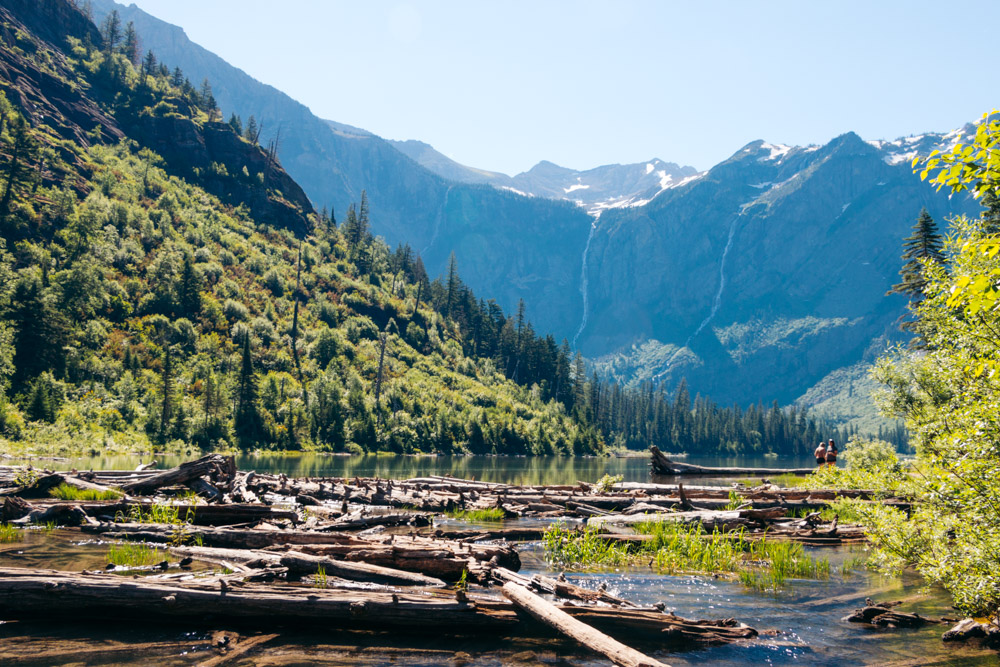
9. Waterfalls at Avalanche Lake in West Glacier
The waterfalls at Avalanche Lake in West Glacier are part of a larger and more grandiose picture. Cascading down the mountainside at the far end of the lake, they add extra charm and natural splendor to the already surreal surroundings.
Hike: To photograph these remarkable waterfalls in West Glacier, however, you must hike first. The lake sits at the end of a 2-mile trail that forks from the Trail of the Cedars. The hike is easy, gradually gaining and losing elevation.
While the trail doesn’t really spoil you with other photogenic sites (except for that part of the path that runs along Avalanche Creek), Avalanche Lake with its threadlike waterfalls rewards with some of the best vistas in entire Glacier National Park.
The most prominent waterfall here is Sperry-Glacier-fed Monument Falls. Overlooking the lake from the height of over 1,800 feet, it’s the highest waterfall in the area. A number of unnamed waterfalls surround it. Creating a spectacular display of the gushing down water, this web of waterfalls is worth every Glacier National Park’s photographer’s attention.
READ MORE: How to Hike to Avalanche Lake (+ The Trail of the Cedars and Avalanche Gorge)
10. Tiny Waterfall at the Trail of the Cedars
Since we’re talking about the waterfalls surrounding Avalanche Lake, it’s worth to add here the dramatic waterfall at the Avalanche Gorge Overlook. Astounding with its force, the peculiar falls stops you in your tracks. Moss covered trees and rocks on both sides of it further dramatize the surroundings, making you reach out for your camera at once.
Hike: Hiking is also an inevitable part of the photographic journey to one of the smallest waterfalls in Glacier. The trail, however, is a piece of cake even for a toddler who just learned how to walk. Starting at the Trail of the Cedars trailhead, it follows a paved path, then runs along a raised boardwalk just to end at a well-trodden dirt trail that leads back to a parking lot. The loop is only 0.7 mile long.
TIP: Yet even Avalanche Gorge with one of the most photographed waterfalls in Glacier National Park is not without its challenges. You must be an early bird to claim a parking space at the trailhead and enjoy the photogenic site. Otherwise, expect to drive around, waiting for a parking spot to open up before you can rush to the falls with your camera, ready to shoot.
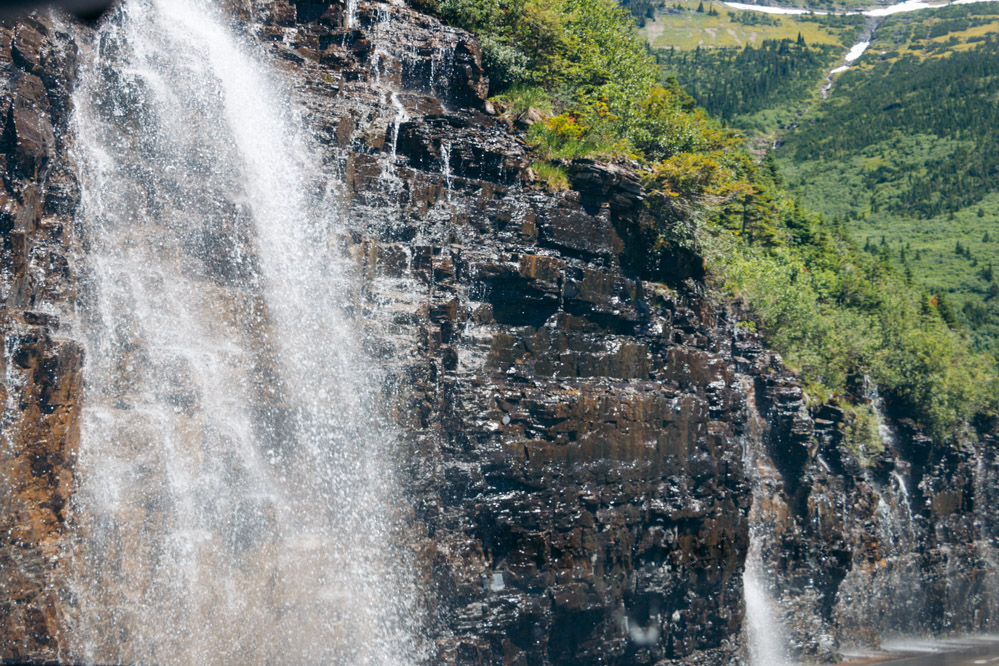
11. Weeping Wall at Glacier’s Going-to-the-Sun Road
The Weeping Wall also joins the ranks of the most photographed waterfalls in Glacier. Running down from a wall cliff located in the eastern section of the Going-to-the-Sun Road, the site surprises even the most experienced waterfall photographers.
Melted snow on the Garden Wall is responsible for the creation of this roadside attraction. After the water runs off the wall, it streams down the mountainside through specially designated vents. When the snowmelt is heavy, the waterfall can reach over 100 feet in width, offering plenty of opportunities to photograph the site from a slowly passing by car.
Fun Fact: The Weeping Wall is one of few waterfalls in Glacier to offer a free car wash. Do you also need a “refreshing shower” on a hot summer day? Roll down your window, and let the pleasant mist spray over you.
Photography Tip: Keep your camera away from the water drops, though. You don’t want your quest for the the most photographed cascades and waterfalls in Glacier to end right here.
The Weeping Wall experiences the heaviest flow in spring and early summer. By August, though, it looks like a trickle.
TIP: When you drive east to west, the Weeping Wall sits to your right, allowing you to get the closest look of its magic. This position, however, is no ideal for Glacier’s waterfall photography. You can’t stop to take a better picture, as other cars follow you. The images, taken while driving, may look blurry, though. You can try to slow down a little bit. There are pretty good chances that the visitors in the cars behind you are equally preoccupied with the waterfall and don’t mind to drive slower here.
12. Cascades near Redrock
When it comes to the gorgeous roadside cascades, look no further than mini-waterfalls near Redrock in West Glacier. Sitting along the Going-to-the-Sun Road, these gushing waterfalls offer some of the epic photo perspectives on the Glacier’s watery abundance.
TIP: One of the best places to shoot these cascades is a small bridge set opposite to the site.
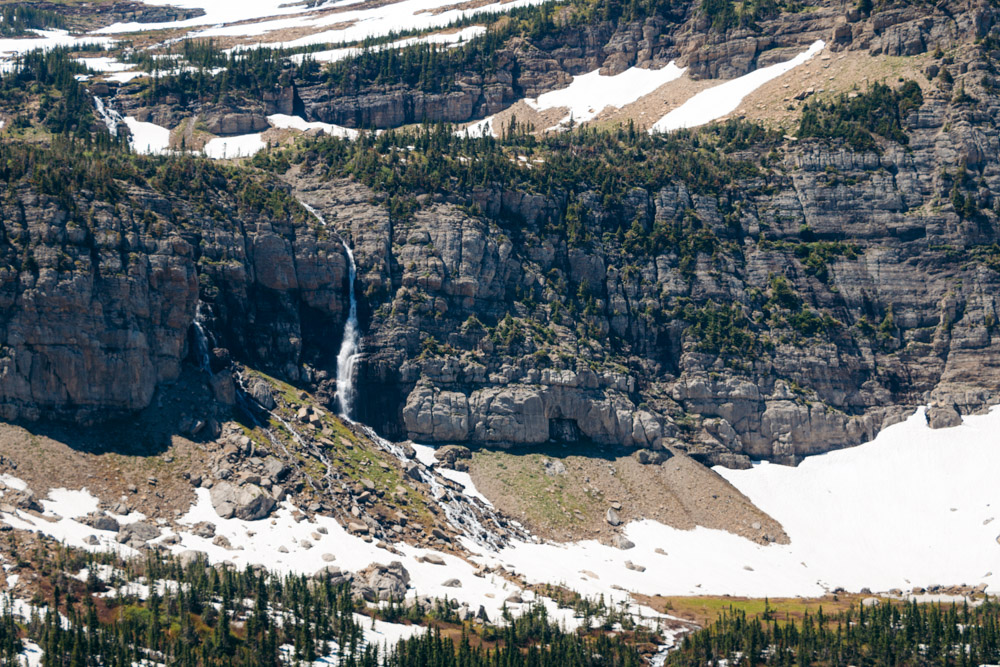
THE MOST PHOTOGRAPHED WATERFALLS IN MANY GLACIER
13. Apikuni Falls in Many Glacier
One of the most photographed waterfalls in Many Glacier is Apikuni Falls. The two-tier natural attraction sits at the end of the 1-mile Apikuni Falls Trail.
The first layer, flowing from the top of a cliff, can be seen and photographed at a distance, from the Many Glacier Hotel parking lot. The second waterfall visually elbows the first one and is of most interest to the Glacier’s landscape photographers.
TIP: When you visit Apikuni Falls in late summer or fall, the natural attraction may slightly disappoint you. In spring, however, it’s a place of sheer delight. Fed by the abundant melted snow, Apikuni Falls is considered one of the favorite waterfalls to photograph in Glacier at this time.
READ MORE: First-Timer’s Guide to Visiting Many Glacier in Glacier National Park: 1 – 2 Day Itinerary
14. Waterfalls Surrounding Grinnell Glacier
The crown jewel of Many Glacier, the Grinnell Glacier area is home to several major waterfalls, created in place of the receding glacier. Photographer’s paradise is the right phrase to describe this pleasing to the eye place. Adorned with the panoramic vistas of aquamarine Grinnell Lake, the 5.3 Grinnell Glacier Viewpoint Trail is indeed dotted with the waterfalls flowing down the mountainside.
When undertaking this hiking/photographic journey in the Many Glacier area in summer, you can even dip your feet in the freezing cold, cascading waters of some of these waterfalls before resuming your walk.
Yet not all falls in the Grinnell Glacier area look equally beautiful. With that said, Thunderbird Falls is far from being one of the most photogenic waterfalls in Glacier. Yet it’s certainly has its own charm, especially when you look for a temporary safe haven from the scorching summer heat.
The highest falls in this area is Grinnell Falls. The waterfall cascades down from the height of 960 feet before depositing into picture-perfect Grinnell Lake. Fed by the meltwater of Grinnell Glacier, Grinnell Falls puts on a show for a longer period of time that other waterfalls in the area.
Yet like some other places in Glacier National Park, the waterfalls surrounding Grinnell Glacier depict a sad story of slowly disappearing glaciers. Just look at Salamander Falls. The towering in the distance waterfall spills directly into Upper Grinnell Lake, a place once reigned solely by Grinnell Glacier.
Map of the Most Photographed Waterfalls and Cascades in Glacier National Park
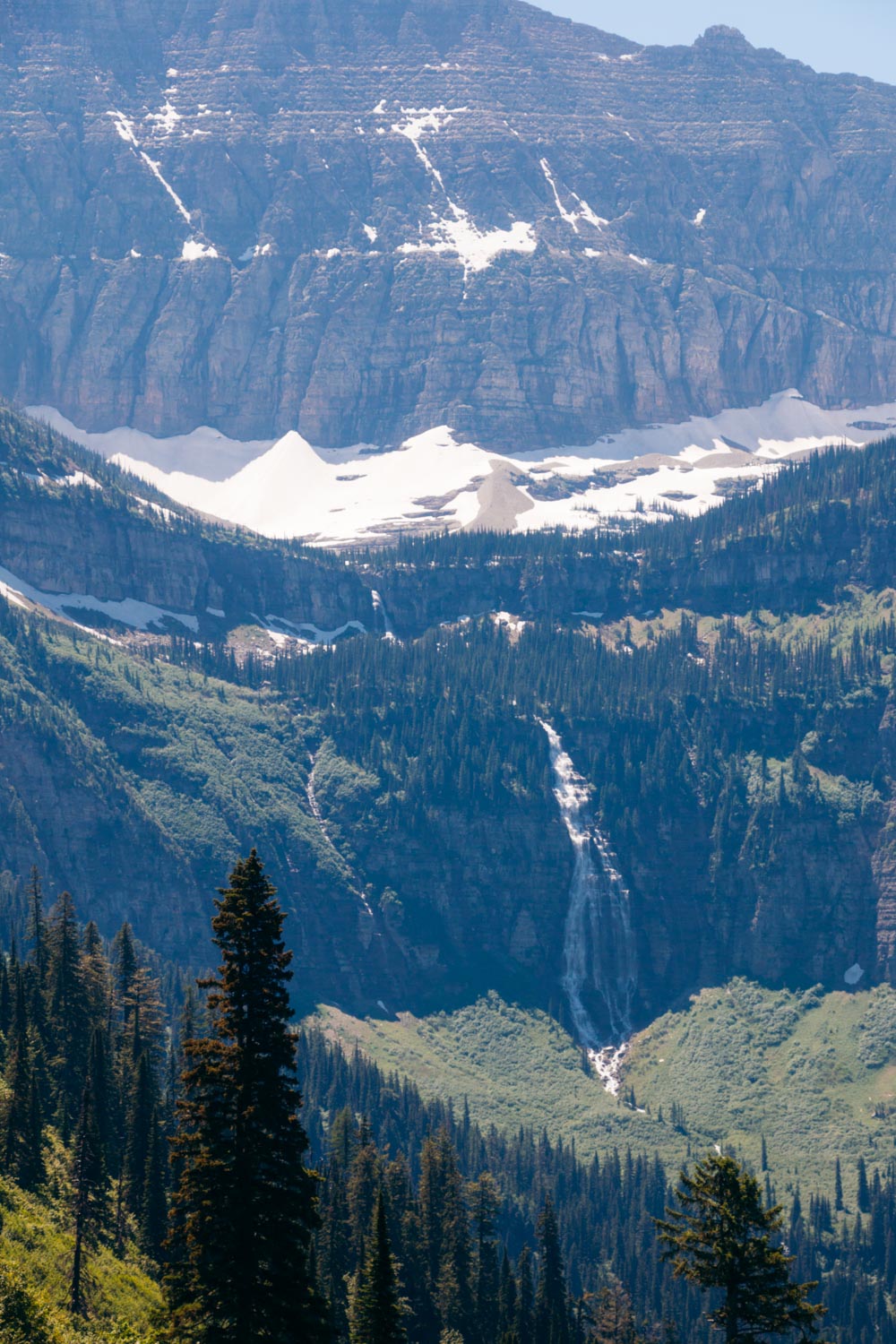
Bird Woman Falls 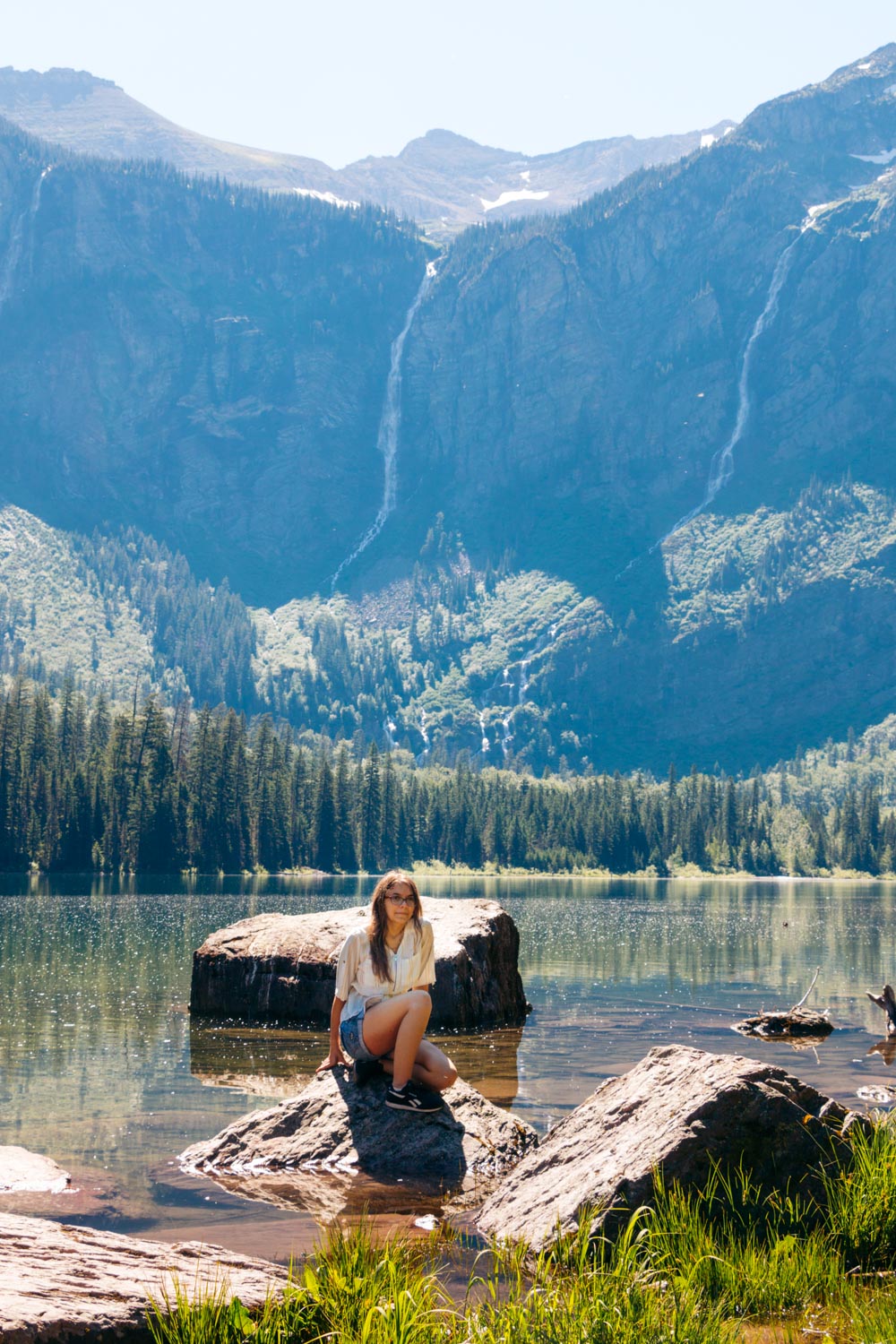
Waterfalls at Avalanche Lake in West Glacier
Tips on how to Photograph Waterfalls and Cascades in Glacier National Park
Spring is the Best Time to Photograph Waterfalls and Cascades in Glacier
Fed by the melted snow, in spring, the majority of waterfalls and cascades in Glacier put on their best shows. Several glacier-sourced falls, such as Baring Falls, however, amaze with their cascading layers throughout the year. Therefore, if you plan to photograph the waterfalls in Glacier during any other seasons but spring, make sure to know where they get their water supplies.
Use Wide-Angle and Telephoto Lenses
When photographing the waterfalls in Glacier from a near distance, the water drops and moist released into the air can land on your camera’s lens. Every photographer knows that even the smallest drop of moisture on the equipment can ruin a photo. Furthermore, the water and cameras don’t usually coexist. The excess of the first can lead to the damage of the latter.
The best solution to this problem is to photograph the Glacier National Park’s waterfalls and cascades from a distance. To make up for the lost closeness, use a telephoto lens. A wide-angle lens works wonders when you photograph rather small waterfalls from a close distance.
Bring along Tripod
The Glacier National Park’s waterfalls can look transformed when using different camera settings. For the roaring falls, adjust your aperture to f/8 or f/10. The stringy waterfalls look better when captured with the long shutter speed of f/22. When shooting at this setting, you should always use a tripod to reduce blurriness in your pictures of Glacier National Park’s waterfalls.
Use the Lowest ISO
The lowing ISO (ISO 100) ensures better quality of your images. Simultaneously, it enables you to decrease the shutter speed and get those smooth shots of the Glacier National Park’s waterfalls.
Photograph Cascades and Waterfalls in Glacier during Sunrise or Sunset
Show up at sunrise or sunset and photograph away. The light at these times is soft and adds extra colors to your images. Midday works equally good for the heavily shaded waterfalls.
Cloudy Days are the Second Best Time to Photograph Waterfalls and Cascades in Glacier
Don’t underestimate the power of overcast weather. The cloudy sky helps easily escape harsh sunlight. As a bonus, you can photograph the gorgeous waterfalls and cascades in Glacier all day long. No need to get up before sunrise or linger around, waiting for the sunset. And the colors look as good as ever.
Read More
- 8 Iconic Photo Spots in Glacier National Park
- 5 Best Places to See and Photograph Wildlife in Glacier National Park
- 5 Iconic Photo Spots in Grand Teton
- 12 Iconic Photo Spots in Los Angeles
- 8 Best Hollywood Sign Photo Spots in Los Angeles
- Chasing Waterfalls in Yosemite National Park
If you enjoyed this blog post, don’t forget to pin it for later and share it with your friends.
